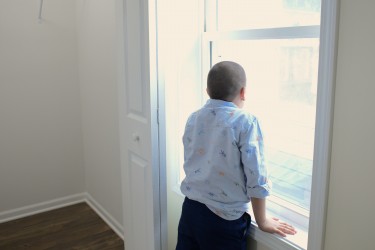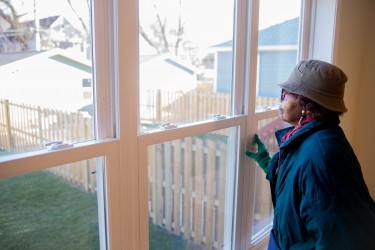HOUSING AND HEALTH DURING COVID-19: COMMUNITY CONDITIONS
This article is a part of our Housing and Health during COVID-19 series. Others in the series include: Housing Conditions and Affordability.
Since the outbreak of COVID-19 began earlier this year, it’s been hard to go a day without thinking about health. Am I feeling sick today? Or, do I have any symptoms of COVID-19 today? And, when one thinks about maintaining their health in these times, we generally think of diet, exercise, and social distancing. However, these factors do not paint the full picture of what contributes to positive or negative health outcomes. In fact, 80-90% of health outcomes may be accounted for by social determinants of health, rather than traditional medical care.¹
Social Determinants of Health
Social determinants of health are the things in a community – like transportation, fresh food, social groups, economic opportunities, and the built environment – that impact health on a daily basis. By living where we do, we experience and interact with our communities every day, and the conditions of these spaces shape us, how we live, and ultimately, how healthy we are. For example, a walkable community with access to outdoor space provides more opportunities for physical activity and access to grocery stores and fresh food can affect long-term nutrition.
When viewing community conditions in the context of COVID-19, we begin to see that neighborhood health really matters for individual health outcomes, and that where we live has the potential to impact health outcomes related to COVID-19.
Community Conditions and Health Outcomes
Community conditions are directly related to the assets present in a neighborhood. These assets may include parks, schools, art centers, commercial centers, block clubs, and cultural organizations, and they all work together to create the social, physical, and economic landscape of a neighborhood. Based on how robust or absent these assets are within a community, they provide or prevent opportunities for physical activity, social connection, and even personal growth, making them important for health outcomes as well.
Neighborhoods lacking essential community assets can often trace their present disparities back through history. Redlining and systemic racism led to a trend of historical disinvestments that resulted in areas of concentrated disadvantage, with lines being drawn along racial and ethnic lines.²
A Tale of Two Neighborhoods and their Health Outcomes
Let’s take a look at two neighborhoods in Chicago: Englewood (zip code 60621) and Streeterville (zip code 60611). Though these two neighborhoods are less than 10 miles apart, they have a life expectancy disparity of 30 years – the largest gap in the US.³
|
|
Englewood (60621) |
Streeterville (60611) |
|||||||||||||||||||||||||||||||||||||||||||||||||||||||||||||||||||||||||||||||||||||||||||||||||||||||||||||||||||||||||||||||||||||||||||||||||||||||||||||||||||||||||||||||||||||||||||||||||||||||||||||||||||||||||||||||||||||||||||||||||||||||||||||||||||||||||||||||||||||||||||||||||||||||||||||||||||||||||||||||||||||||||||||||||||||||||||||||||||||||||||||||||||||||||||||||||||||||||||||||||||||||||||||||||||||||||||||||||||||||||||||||||||||||||||||||||||||||||||||||||||||||||||||||||||||||||||||||||||||||||||||||||||||||||||||||||||||||||||||||||||||||||||||||||||||||||||||||||||||||||||||||||||||||||||||||||||||||||||||||||||||||||||||||||||||||||||||||||||||||||||||||||||||||||||||||||||||||||||||||||||||||||||||||||||||||||||||||||||||||||||||||||||||||||||||||||||||||||||||||||||||||||||||||||||||||||||||||||||||||||||||||||||||||||||||||||||||||||||||||||||||||||||||||||||||||||||||||||||||||||||||||||||||||||||||||||||||||||||||||||||||||||||||||||||||||||||||||||||||
|
Life Expectancy |
60 years |
90 years |
|||||||||||||||||||||||||||||||||||||||||||||||||||||||||||||||||||||||||||||||||||||||||||||||||||||||||||||||||||||||||||||||||||||||||||||||||||||||||||||||||||||||||||||||||||||||||||||||||||||||||||||||||||||||||||||||||||||||||||||||||||||||||||||||||||||||||||||||||||||||||||||||||||||||||||||||||||||||||||||||||||||||||||||||||||||||||||||||||||||||||||||||||||||||||||||||||||||||||||||||||||||||||||||||||||||||||||||||||||||||||||||||||||||||||||||||||||||||||||||||||||||||||||||||||||||||||||||||||||||||||||||||||||||||||||||||||||||||||||||||||||||||||||||||||||||||||||||||||||||||||||||||||||||||||||||||||||||||||||||||||||||||||||||||||||||||||||||||||||||||||||||||||||||||||||||||||||||||||||||||||||||||||||||||||||||||||||||||||||||||||||||||||||||||||||||||||||||||||||||||||||||||||||||||||||||||||||||||||||||||||||||||||||||||||||||||||||||||||||||||||||||||||||||||||||||||||||||||||||||||||||||||||||||||||||||||||||||||||||||||||||||||||||||||||||||||||||||||||||||
|
Median Income |
$21,275 |
$85,642 |
|||||||||||||||||||||||||||||||||||||||||||||||||||||||||||||||||||||||||||||||||||||||||||||||||||||||||||||||||||||||||||||||||||||||||||||||||||||||||||||||||||||||||||||||||||||||||||||||||||||||||||||||||||||||||||||||||||||||||||||||||||||||||||||||||||||||||||||||||||||||||||||||||||||||||||||||||||||||||||||||||||||||||||||||||||||||||||||||||||||||||||||||||||||||||||||||||||||||||||||||||||||||||||||||||||||||||||||||||||||||||||||||||||||||||||||||||||||||||||||||||||||||||||||||||||||||||||||||||||||||||||||||||||||||||||||||||||||||||||||||||||||||||||||||||||||||||||||||||||||||||||||||||||||||||||||||||||||||||||||||||||||||||||||||||||||||||||||||||||||||||||||||||||||||||||||||||||||||||||||||||||||||||||||||||||||||||||||||||||||||||||||||||||||||||||||||||||||||||||||||||||||||||||||||||||||||||||||||||||||||||||||||||||||||||||||||||||||||||||||||||||||||||||||||||||||||||||||||||||||||||||||||||||||||||||||||||||||||||||||||||||||||||||||||||||||||||||||||||||||
|
Diabetes-related Hospitalizations |
46.4 per 10,000 population |
5.5 per 10,000 population |
|||||||||||||||||||||||||||||||||||||||||||||||||||||||||||||||||||||||||||||||||||||||||||||||||||||||||||||||||||||||||||||||||||||||||||||||||||||||||||||||||||||||||||||||||||||||||||||||||||||||||||||||||||||||||||||||||||||||||||||||||||||||||||||||||||||||||||||||||||||||||||||||||||||||||||||||||||||||||||||||||||||||||||||||||||||||||||||||||||||||||||||||||||||||||||||||||||||||||||||||||||||||||||||||||||||||||||||||||||||||||||||||||||||||||||||||||||||||||||||||||||||||||||||||||||||||||||||||||||||||||||||||||||||||||||||||||||||||||||||||||||||||||||||||||||||||||||||||||||||||||||||||||||||||||||||||||||||||||||||||||||||||||||||||||||||||||||||||||||||||||||||||||||||||||||||||||||||||||||||||||||||||||||||||||||||||||||||||||||||||||||||||||||||||||||||||||||||||||||||||||||||||||||||||||||||||||||||||||||||||||||||||||||||||||||||||||||||||||||||||||||||||||||||||||||||||||||||||||||||||||||||||||||||||||||||||||||||||||||||||||||||||||||||||||||||||||||||||||||||
|
Preventable Hospitalizations |
371 per 10,000 population |
88.2 per 10,000 population |
|||||||||||||||||||||||||||||||||||||||||||||||||||||||||||||||||||||||||||||||||||||||||||||||||||||||||||||||||||||||||||||||||||||||||||||||||||||||||||||||||||||||||||||||||||||||||||||||||||||||||||||||||||||||||||||||||||||||||||||||||||||||||||||||||||||||||||||||||||||||||||||||||||||||||||||||||||||||||||||||||||||||||||||||||||||||||||||||||||||||||||||||||||||||||||||||||||||||||||||||||||||||||||||||||||||||||||||||||||||||||||||||||||||||||||||||||||||||||||||||||||||||||||||||||||||||||||||||||||||||||||||||||||||||||||||||||||||||||||||||||||||||||||||||||||||||||||||||||||||||||||||||||||||||||||||||||||||||||||||||||||||||||||||||||||||||||||||||||||||||||||||||||||||||||||||||||||||||||||||||||||||||||||||||||||||||||||||||||||||||||||||||||||||||||||||||||||||||||||||||||||||||||||||||||||||||||||||||||||||||||||||||||||||||||||||||||||||||||||||||||||||||||||||||||||||||||||||||||||||||||||||||||||||||||||||||||||||||||||||||||||||||||||||||||||||||||||||||||||||
Data: City Health Dashboard, CMAP, Chicago Health Atlas, Chicago Sun Times
Englewood is a majority-Black neighborhood in Chicago that has historically been impacted by disinvestment and redlining. Throughout the 1900s, residents were unable to acquire loans to purchase homes or start businesses,⁴ and this has led to long-term financial implications for the community.⁵ Today, the community conditions of Englewood reflect the discriminating policies of the past. As seen from the chart above, the neighborhood is confronted with a low median income, lower than average life expectancy, and higher than average hospitalizations.
Meanwhile, the neighborhood of Streeterville is predominately white, and has never suffered from lending discrimination. The area now has a higher than average median income, the highest life expectancy in the city, and lower than average health incidents. Located close to the city’s down town area, this neighborhood has seen robust investments in the forms of real estate, commerce, and urban development.
Community Conditions in the era of COVID-19
In the light of the COVID-19 pandemic, the relationship between health and neighborhood has become even more prominent. As of August, Englewood has recorded over twice as many COVID-19 cases per 1,000 people compared to Streeterville.
|
|
Englewood (60621) |
Streeterville (60611) |
|||||||||||||||||||||||||||||||||||||||||||||||||||||||||||||||||||||||||||||||||||||||||||||||||||||||||||||||||||||||||||||||||||||||||||||||||||||||||||||||||||||||||||||||||||||||||||||||||||||||||||||||||||||||||||||||||||||||||||||||||||||||||||||||||||||||||||||||||||||||||||||||||||||||||||||||||||||||||||||||||||||||||||||||||||||||||||||||||||||||||||||||||||||||||||||||||||||||||||||||||||||||||||||||||||||||||||||||||||||||||||||||||||||||||||||||||||||||||||||||||||||||||||||||||||||||||||||||||||||||||||||||||||||||||||||||||||||||||||||||||||||||||||||||||||||||||||||||||||||||||||||||||||||||||||||||||||||||||||||||||||||||||||||||||||||||||||||||||||||||||||||||||||||||||||||||||||||||||||||||||||||||||||||||||||||||||||||||||||||||||||||||||||||||||||||||||||||||||||||||||||||||||||||||||||||||||||||||||||||||||||||||||||||||||||||||||||||||||||||||||||||||||||||||||||||||||||||||||||||||||||||||||||||||||||||||||||||||||||||||||||||||||||||||||||||||||||||||||||||
|
COVID-19 cases per 1000 people |
24.2 |
10.4 |
|||||||||||||||||||||||||||||||||||||||||||||||||||||||||||||||||||||||||||||||||||||||||||||||||||||||||||||||||||||||||||||||||||||||||||||||||||||||||||||||||||||||||||||||||||||||||||||||||||||||||||||||||||||||||||||||||||||||||||||||||||||||||||||||||||||||||||||||||||||||||||||||||||||||||||||||||||||||||||||||||||||||||||||||||||||||||||||||||||||||||||||||||||||||||||||||||||||||||||||||||||||||||||||||||||||||||||||||||||||||||||||||||||||||||||||||||||||||||||||||||||||||||||||||||||||||||||||||||||||||||||||||||||||||||||||||||||||||||||||||||||||||||||||||||||||||||||||||||||||||||||||||||||||||||||||||||||||||||||||||||||||||||||||||||||||||||||||||||||||||||||||||||||||||||||||||||||||||||||||||||||||||||||||||||||||||||||||||||||||||||||||||||||||||||||||||||||||||||||||||||||||||||||||||||||||||||||||||||||||||||||||||||||||||||||||||||||||||||||||||||||||||||||||||||||||||||||||||||||||||||||||||||||||||||||||||||||||||||||||||||||||||||||||||||||||||||||||||||||||
Data: WBEZ
When looking at the disparities between zip codes and their COVID-19 cases, the trend is clear: neighborhood conditions matter. Based on where you live, and whether or not your community has faced redlining or other systemic disinvestments, you may be more or less at risk for contracting COVID-19.
Responding to Community Health Disparities through Re-Investment
The City of Chicago recognized early on that some community areas in the city are facing disproportionate burdens of the pandemic and launched the Racial Equity Rapid Response Team to address systemic health inequalities faced by minority communities in in the face of COVID-19.⁶
These inequalities can only be truly remedied by holistic and comprehensive investments across the city. One such effort that may stem the pernicious effects of historic disinvestment in certain neighborhoods in Chicago is the recently launched the Invest SouthWest Initiative. This initiative is a coordinated effort between government, businesses, and community organizations to strategically and inclusively reinvest in 10 neighborhoods on the city’s South and West sides.
At Habitat Chicago, we are doing our part to bring thoughtful, tailored investments to the communities with whom we work. In addition to our community-focused housing developments, our Neighborhood Grants Initiative provides direct funding for resident-led projects in West Pullman and Greater Grand Crossing. These Grants aim to strengthen community assets that are tied to the social determinants of health, improving long-term outcomes for the neighborhoods. Projects have included community unity campaigns to build cohesion between two disparate areas of a neighborhood, solar yard light installations to bring more light and enhanced safety to entire neighborhood blocks, and community garden initiatives to increase fresh food options in the community.
We know that investments big and small can have catalytic effects in neighborhoods, and to work toward a Chicago in which everyone has a decent, healthy place to live, we will need to continue making holistic, intentional investments into communities that have historically faced disinvestment and structural inequalities.
What you can do
Support our work in West Pullman and Greater Grand Crossing by donating to our COVID-19 Resiliency Fund so we can continue investing in neighborhoods that have long faced disinvestment and are most vulnerable to the long-term effects of the pandemic.
Sources
- https://nam.edu/social-determinants-of-health-101-for-health-care-five-plus-five/
- https://www.chicagotribune.com/living/health/ct-life-inequity-data-policy-roots-chicago-20200726-r3c7qykvvbfm5bdjm4fpb6g5k4-story.html
- https://www.chicagotribune.com/business/ct-biz-chicago-has-largest-life-expectancy-gap-between-neighborhoods-20190605-story.html
- https://interactive.wbez.org/2020/banking/disparity/
- https://www.chicagofed.org/publications/working-papers/2017/wp2017-12
- https://www.chicago.gov/city/en/depts/mayor/press_room/press_releases/2020/april/RERRTUpdate.html

